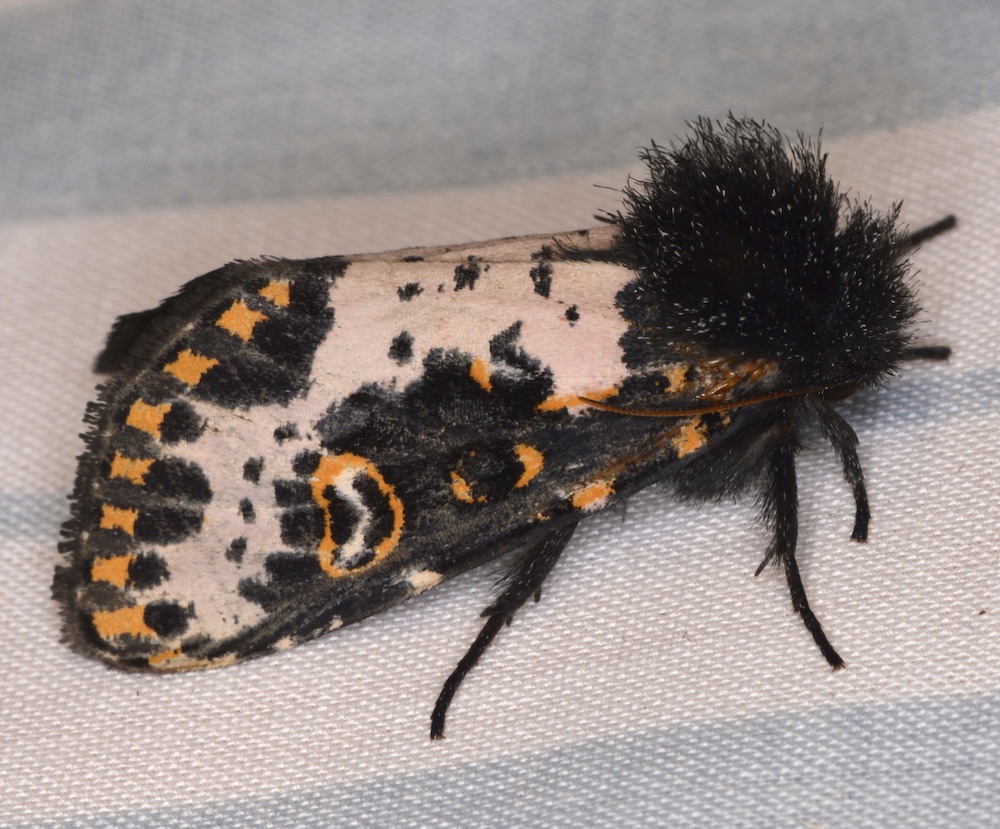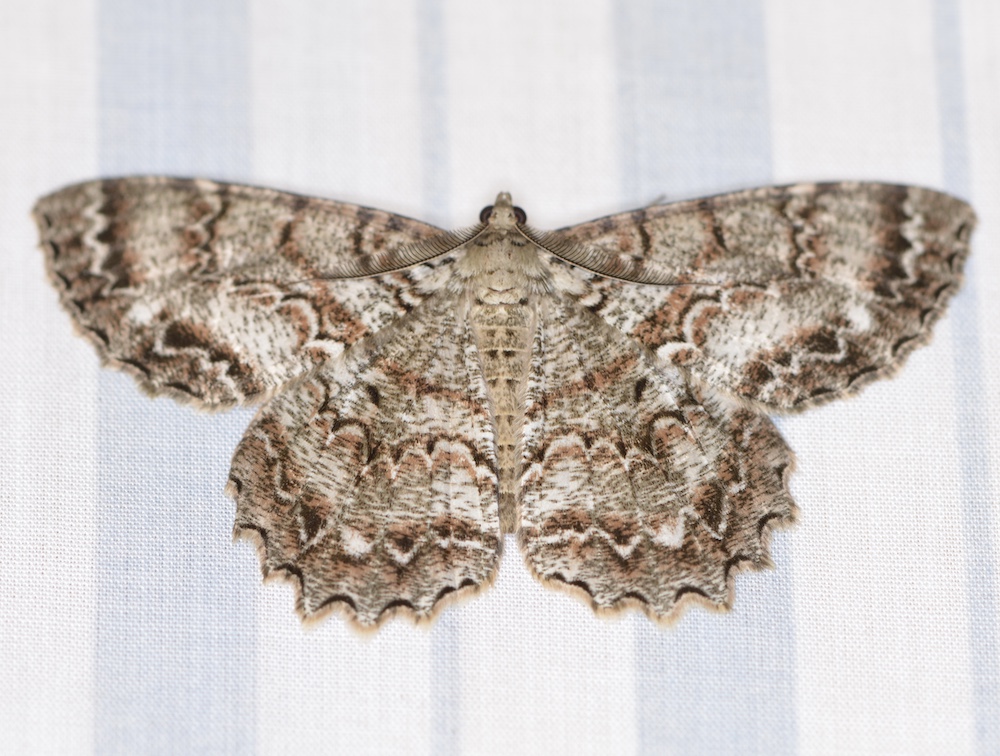Carolina Beach Survey Update

Stephen Dunn and I just completed our first survey trip to Carolina Beach State Park, and I learned a great deal in the process. This was my first time trapping in the field, and it was not a success. Although I made a few mistakes, the biggest problem was probably the weather. In addition to a violent thunderstorm with hail the first night, wind was an issue both nights. However, we did get some good results on the sheet we set up next to our cabin. The highlight was a Spanish Moth (Xanthopastis regnatrix), pictured here. A spectacular moth, it is commonly found in Florida, but rarely ranges up as far as North Carolina, and has only been recorded in the southeastern corner of the state.
The first night, I only set up one trap near the cabin as the forecast was calling for late-night thunderstorms. This prediction proved accurate, and the hail on the cabin's metal roof made sleep impossible. The next day, the park rangers told us that they found two dead deer on one of the trails, killed by lightning during the night. The second night we set up our traps in two promising locations, one near a boardwalk in a swampy section of maritime forest, and the other two in a more open area near a limesink pond. In retrospect, the second location was probably too open considering the steady winds. We ended up with very few moths (and too many beetles) in the traps. Erich Hofmann was able to join us at the park, and was a great help with setting out the traps.
Compared with the traps, the sheet was quite successful. While Steve and Bo's thorough survey probably got most of the macro-moths we might see at the park, they did not survey micros, so it was possible to add many new records for the park. Below is a list of the species we observed. (* = county record)

- Afflicted Dagger (Acronicta afflicta)
- Smeared Dagger (Acronicta oblinata)*
- Yellow-spotted Webworm (Anageshna primordialis)
- Juniper Seed Moth (Argyresthia alternatella)*
- Battaristis new species (Battaristis sp.)* - an undescribed but previously know species
- Stripe-backed Moth (Battaristis vittella)*
- Vetch Looper (Caenurgia chloropha)
- Conglomerate Oak Leafminer (Cameraria conglomeratella)*
- Rusty Oak Leafminer (Cameraria quercivorella)*
- Celypha Moth (Celypha cespitana)*
- Double-lined Gray (Cleora sublunaria)
- Garden Tortrix (Clepsis peritana)
- Common Grass-veneer (Crambus praefectellus)
- Hickory Shuckworm (Cydia caryana)*
- Cydia erotella*
- Reticulated Decantha (Decantha boreasella)*
- Many-spotted Dichomeris (Dichomeris punctipennella)*
- Southern Pineconeworm (Dioryctria amatella)*
- Blister Coneworm (Dioryctria clarioralis)*
- Alternate Woodling (Egira alternans)
- Festive Midget (Elaphria festivoides)
- Bidens Borer (Epiblema otiosana)*
- Tulip-tree Beauty (Epimecis hortaria)
- Maple Tip Borer (Episimus tyrius)*
- Eriocraniella mediabulla*
- Forked Euchlaena (Euchlaena deductaria)
- Obtusde Euchlaena (Euchlaena obtusaria)
- Striped Eudonia (Eudonia strigalis)*
- Common Eupithecia (Eupithecia miserulata)
- Cherry Fruitworm (Grapholita packardi)*
- Fall Webworm (Hyphantria cunea)
- Large Necklace Moth (Hypsoropha monilis)
- Common Idia (Idia aemula)
- Black-dotted Ruddy (Ilexia intractata)
- Laudable Arches (Lacinipolia laudabilis)
- Southern Pine Sphinx (Lapara coniferarum)
- Linen Wainscot (Leucania linita)
- Blurry Chocolate Angle (Macaria transitaria)
- Signate Melanolophia (Melanolophia signataria)
- Yellow-washed Mettaranthis (Metarranthis obfirmaria)
- Darker Moodna (Moodna ostrinella)*
- Paler Moodna (Moodna pallidostrinella)*
- Armyworm Moth (Mythimna unipuncta)
- Riley's Nemapogon (Nemapogon rileyi)*
- Sorghum Webworm (Nola cereella)
- Sweet Pepperbush Nola (Nola clethrae)
- Rustic Quaker (Orthodes majuscula)
- Faint-spotted Palthis (Palthis asopialis)
- Georgian Prominent (Paraeschra georgica)
- Robinson's Pelochrista (Pelochrista robinsonana)
- Gray Perimede (Perimede erransella)*
- Titian Peale's Pyralid (Perispasta caeculalis)*
- Common Oak Moth (Phoberia atomaris)
- Phyllocnistis hyperpersea* - leaf mines
- Phyllocnistis subpersea* - leaf mines
- Moonseed Moth (Plusiodonta compressipalpis)
- Cadbury's Mystique (Polygrammate cadburyi)
- Hebrew Moth (Polygrammate hebraeicum)
- Carpenterworm Moth (Prionoxystus robiniae)
- Common Ptichodis (Ptichodis herbarum)
- Diminutive Grass-veneer (Raphiptera argillaceellus)*
- Dotted Renia (Renia salusalis)*
- Winterberry Moth (Rhopobota dietziana)*
- Rival Wave (Scopula aemulata)
- Yucca Moth (Tegeticula yuccasella)* - bore holes in Yucca seedpods
- Smoky Tetanolita (Tetanolita mynesalis)
- Evergreen Bagworm (Thyridopteryx ephemeraeformis) - cocoons
- Celery Leaftier (Udea rubigalis)
- Sheathed Quaker (Ulolonche culea)
- Dried Fruit Moth (Vitula edmandsii)*
- Spanish Moth (Xanthopastis regnatrix)
- Zale intenta/lunifera
In all, that is 30 species added to New Hanover County. Not bad for two nights of sheet sampling in a campground. March was pretty early in the year for sampling, and the weather did not cooperate, so I am excited about returning to the park later in the year. Currently I am aiming for sometime around the new moon on May 19.